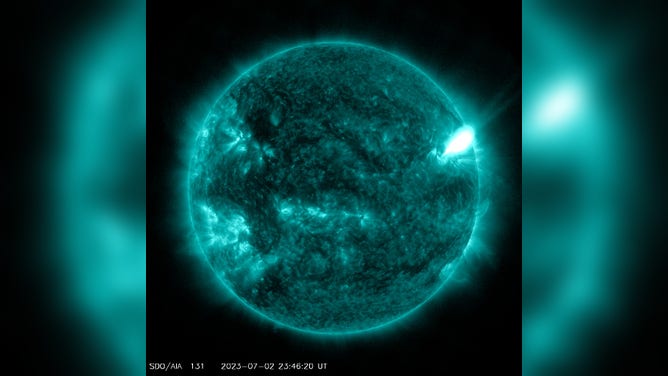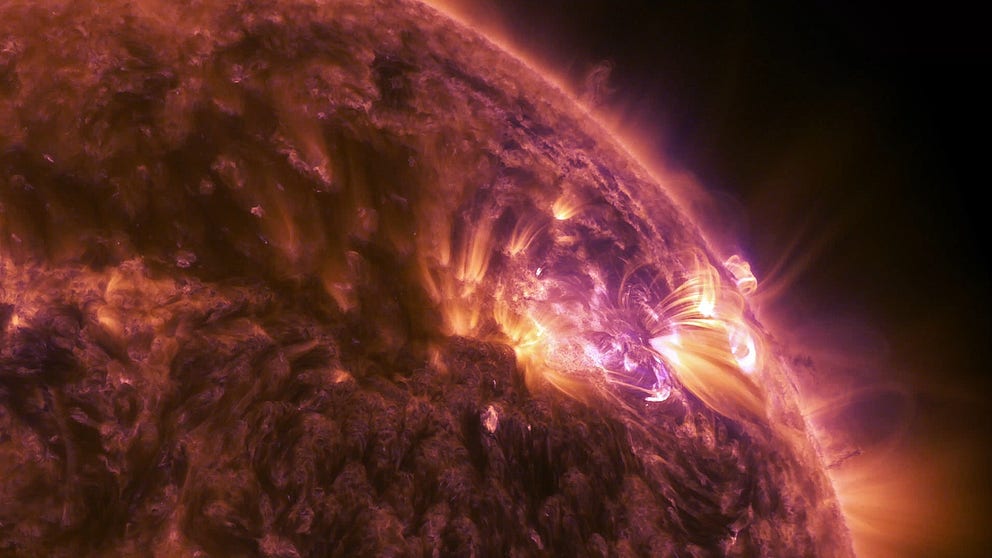Back-to-back solar storms headed for Earth could create dazzling auroras, power grid fluctuations
This is the second solar storm in a week. The combo could produce auroras in the northern tier, according to forecast models.
Space weather explained: What is a solar flare?
The largest explosions in the solar system, a solar flare is an explosion of energy that occurs on the sun’s surface, often appearing as a localized burst of bright light.
Back-to-back solar storms, including one on the Fourth of July, could potentially result in brighter auroras and power grid fluctuations on Earth.
While your neighbors were preparing to put on a fireworks show Tuesday evening, the sun was ejecting a powerful burst of energy, putting on its own show.
The NOAA Space Weather Prediction Center (SWPC) in Boulder, Colorado, said a coronal mass ejection, or CME, was observed by a NASA satellite on July 4.
The Independence Day solar activity prompted the SWPC to issue a Geomagnetic Storm Watch. The prediction center is forecasting the solar storm to reach Earth’s atmosphere by late Thursday or early Friday.
This storm is a minor G1-level rated storm on NOAA’s 5-level scale to rate the potential impacts of any geomagnetic activity headed toward Earth. There is potential for some G2 impacts. For a storm of this level, some weak power grid fluctuations can occur only if it passes Earth with a southward magnetic field and connects with the magnetosphere around the planet.
THE DAY THE NORTHERN LIGHTS COVERED THE PLANET: HISTORY OF EARTH'S GREATEST SOLAR STORMS
For most people, a Geomagnetic Storm Watch is not something to be concerned about. The watches help government agencies, power providers, telecommunication companies and satellite operators prepare to protect systems that are impacted by space weather.

NASA’s Solar Dynamics Observatory captured this image of a solar flare – as seen in the bright flash on the top right area of the Sun – on July 2, 2023.
(NASA/SDO / NASA)
This is the second solar storm in a week requiring a Geomagnetic Storm Watch.
On Sunday, NASA’s Solar Dynamics Observatory (SDO) recorded another solar storm.
Space Weather Physicist Tamitha Skov said on Twitter the July Fourth solar storm is moving faster and will catch up with Sunday's storm, creating a "1,2-punch."
What is an aurora? The northern lights explained
Dancing across the skies in vibrant ribbons of color, auroras are one of nature’s most magnificent natural phenomena.
Skov said NASA models show the solar storm could produce auroras at mid-latitudes.
According to the SWPC aurora forecast, some auroras could appear Thursday in the northern tier.
Sun producing more solar eruptions during active cycle
The Sun is in the midst of an active period in its solar cycle, which lasts 11 years.
NOAA satellites are constantly monitoring the sun for activity which helps the Space Weather Prediction Center issue forecasts. All newer NOAA GOES satellites use an instrument called the Solar Ultraviolet Imager or SUVI to record the sun in ultraviolet wavelengths.
Recently, Space Weather Prediction Center scientist Mark Miesch put together a timelapse showing the Sun's increasing activity.
"Although the Sun is no more active than in previous generations, our society has changed. With our increasing reliance on electric power, global telecommunications, satellite navigation and aviation, we are more sensitive than ever to the Sun's changing moods," Miesch said in a statement. "Stay tuned for more fireworks as we approach yet another solar maximum in 2024."
The increasing activity started in December 2019, with the most recent severe G4 geomagnetic storm in April.
Editor's note: A previous version of this story incorrectly referenced a solar flare instead of a solar storm, or coronal mass ejection, contributing to potential auroras and power grid fluctuations.

